Alan Kay: The future can not be built gradually
The least important time we live in is the present.
Alan Kay
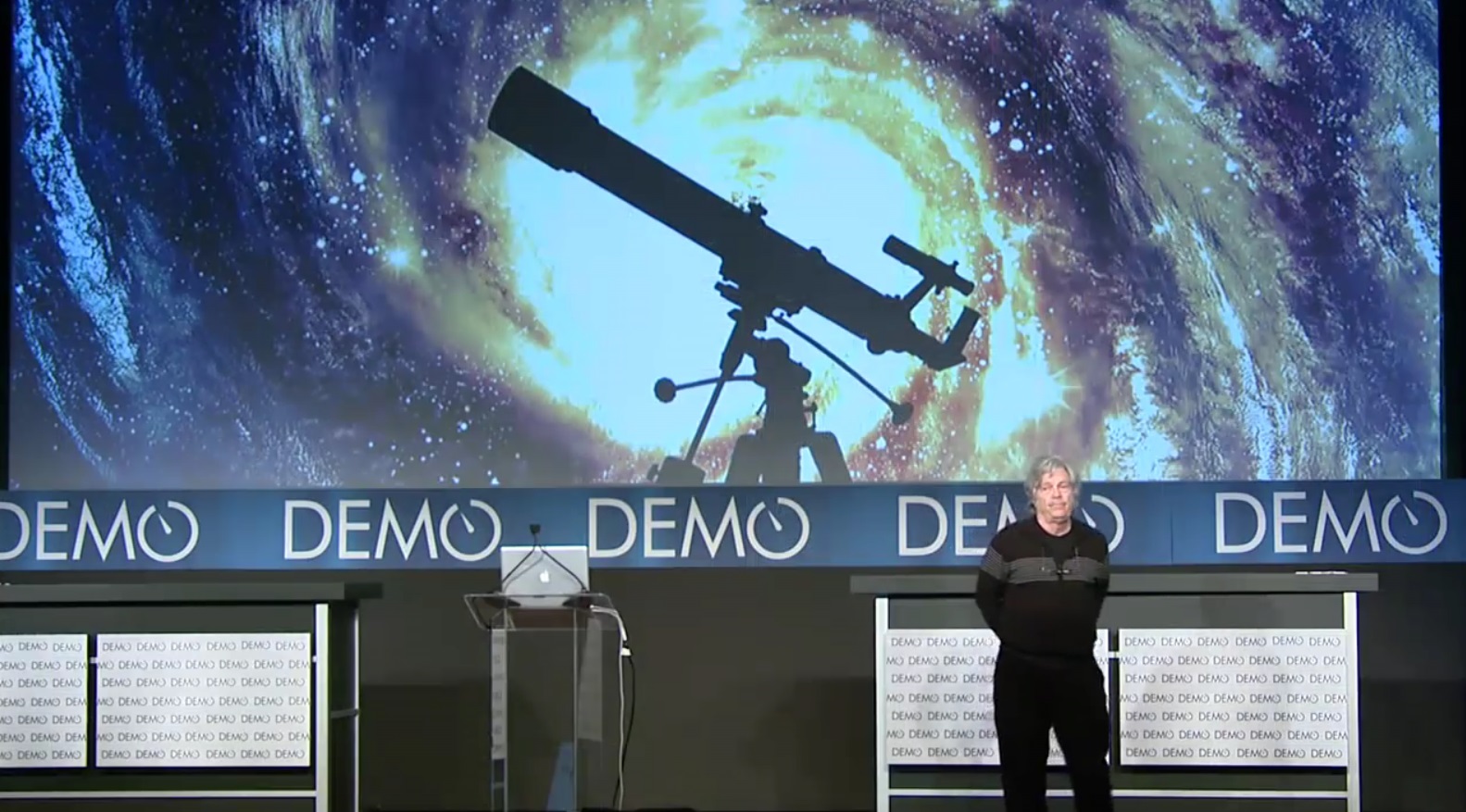
Back in 2014, when Alan Kay gave this speech in San Francisco, one friend was present there personally. He was extremely impressed with the presentation, and he asked him to translate it for a researcher who is already aged and does not know English. Sincerely interested in those who move the thought in the Valley, I agreed. The translation lay unclaimed for a long time, but suddenly a crazy thought came: to take and publish.
Thanks MagisterLudi for editing and help!
I decided to use Stephen's speech as the springboard for my speech, because I know that he likes to make demos, and I also love to make them. This slide summarizes something that we all need to pay attention to, and that is the difference between gradual development and abrupt development.
')
Big Data is a niche in which many today are trying to make money, which is also a favorite of marketers because of its omnipresence. Everyone hears the phrase, but not everyone knows its meaning, this is an excellent reason for marketers to say: “it uses Big Data, it uses Big Data”. But the interesting future lies behind the meaning, the meaning, not the data. Stephen showed you an idea that most people didn't even have - that if the programming language really knew something about its user, about the context, that if he knew something about me. These ideas are quite old, and appeared when many jump-like discoveries. But they were not understood in the 80s, and were simply discarded. And this is an interesting topic to think about.
Some time ago, Regis McKenna (Regis McKenna), who had long been seated in Silicon Valley, was engaged in PR th and promotion, especially for Apple. He got people who confuse the words “innovation” and “invention”. He said that invention is what Xerox PARC does (research center in Palo Alto - approx. Transl.), And innovation is what Apple does. So Xerox invented things that were irregular in development, and it was one kind of work. You can understand this as creating [“scientific”] capital (wealth), the kind of capital you need for a hydroelectric power station or for extracting electricity from solar energy. Innovations mean the conversion of [“scientific”] capital into money, and this is what Apple does, thus doing a completely different kind of work, more complex and expensive - wrapping it in all kinds of wrappers that are needed for the gradual introduction of the invention in the world, overcoming his resistance.
Often, only a fraction of the invention is published.

Because it goes to a world where potential buyers have a comparatively poor understanding of what it is, especially if it is something new. Today I will talk about inventions. Here is an example - 3333 Coyote Hill street (address PARC - approx. Transl.). There, a personal computer (PC) was invented, like the first Apple Mac, of 1988 or 1989. But this one was assembled in 1973, and we first made 2000 pieces, because it is not possible to invent a PC without a PC. Need a demonstration. A bitmap screen, a graphical user interface (GUI) —that is central to making money, because this is what allows billions of people to use computers — object-oriented programming, laser printers, Ethernet, p2p networks, and half the Internet. And much more. All of them were not very similar to what happened before them, and we realized that any invention does not start from scratch. We measured the difference between the invention and the gradual development (innovation) in terms of the size of the technological leap. Interestingly, all this was done by a group of 24 people in 5 years, which is very cheap. In terms of today, using a constant dollar, it cost $ 10 million a year. Of course, then the assets were spent in a completely different way: wages were low, houses were small. When I was there, my salary was $ 22,000, and my house in Palo Alto stood on a third acre and cost $ 45,000. On the other hand, we spent 2-3 salaries on equipment for each employee, and so we bought the road to future. According to Moore's Law, if you now want something that will appear only after 15 years, you should be ready to pay dizzying money. Therefore, our PCs in today's dollars were $ 85,000, and we made 2,000 copies. Think if you go to a university or a company - they work on the computers of the past. Their chances of making something breakthrough are almost nil. If you want to calculate in the future, you need to calculate with the computing power of the future.
And here is the problem: everyone likes change, except for the moment when this change needs to be made
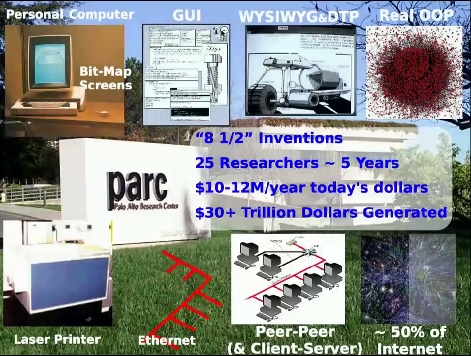
And I do not mean only the public, I am talking about technologists. So perhaps the most interesting fact about PARC is that it generated 30 trillion dollars. And this is another difference between invention and innovation. People are very happy when they created a company that brings in $ 1 or $ 10 billion a year, which is only 1/10 of 1% of $ 1 trillion. An invention that changes context brings a whole new layer of technologies in terms of profitability two or three orders of magnitude higher. And the invention allows innovation to take place: when all the most important has already been created, people can calmly reflect on new ideas. For example, a guy for a couple of speakers before me had small ideas, he created a new company based on each new idea. This brought him Nemer money, and all because the public just the same and can digest only these small ideas. So the most interesting moment for us is that technologists also had problems with this. For example, how we designed computers was rejected by Intel and Motorola, how we created the programming language was rejected by the programmer community, but because PARC was successful, the names were nevertheless stuck. For example, in the 80s, many “object-oriented” (OO) languages appeared, which in my opinion are not (and I am the one who invented this name). C ++ for example is not OO. And we see it all over the place.
People in general hate to learn something new, and we will hear about it in a second, and especially marketing people do not like it
Any project today that involves learning a lot is not interesting for marketers. As a joke: they want a completely new idea, which is already well tested, it should be understandable and identifiable for people, but you are its only owner. That is, they want something that could lure a stone man 100,000 years ago, something that keeps up with our genetically predisposed interests. An interesting question: if the bike was invented tomorrow, how would it stay on the market? Think about how dangerous a bike is, think about how many lawsuits there were. People today are tolerant of a bicycle, all because it is already present for many years. Another side with which you can see: our world is a low pass filter.
The iPod has a stupid interface than the Mac. He does not even have such a function as a “step back”, although it may be that if they are shaken, then some functions will respond to help. But if you think of the iPod as a device with which you communicate with gestures, a gesture is something that is not only natural, but also effective. If you do gestures on a computer, then the roots of this process go back to the 60s, all you really need to do is learn a bunch of gestures on a computer to use it fluently and efficiently, and the iPod has no training programs for these gestures. And they do not force developers to write them. They stupefied everything to a few simple gestures, and this approach is beneficial for people interested in making money, but not for personal calculations.
From which side you can look at this: there are “news”, and there is a “new”

What is news? News is something that can be told in a few minutes. Why? Because if you watch the news on TV, they will not show you what goes beyond the categories that you already know. They will show about the fall of the aircraft, about the shooting, and all this falls into a category about which you already know something. Thus, they move away from the “new”, which by definition is invisible - something that is really new, you can barely consider. Many people who are faced with something really new, they either reject it, or try to reformat it into something they already know. News is about “bonfires” around which we gather and compose fairy tales, we remake tales into the best tales. New things can take years of study to understand what it really is. I can not remember to show something of higher mathematics on the news to help people understand global warming. And at the same time, higher mathematics is known for several hundred years, but in fact only 7% of Americans took a course in higher mathematics, and only 4% understand it. So this is something that will not be shown on TV or in the New York Times. And what would I not do in such a conversation with you, to talk about the “new” I have to use things from the area of “news”. I need to use categories that you understand to complete within the remaining 15 minutes.
If you look at human psychometrics, here’s a simplified, but still interesting concept.

When something new appears, 95% of us are so-called “instrumental thinkers” - people who value an idea or tool based on whether it helps them in achieving their current goals. These people are extremely conservative in changing their goals. 5% of us are really interested in new ideas and tools, and can change our goals when these new things appear.

On the other axis, 85% of people do things for social approval (these are so-called extroverts), and only 15% of us are internally-oriented. Combining these two axes - they may not be completely independent, but sufficiently independent for this performance - we see that only 1% of us are internally oriented and interested in new ideas and tools, and 80% are conservative, instrumental, and directed by public opinion about them . This group needs everyone to agree on something before anyone agrees on something. It does not happen through thinking, and therefore they cannot do something simply because it is a good idea - they simply do not have such a category.

But if everyone agrees with something, but at the same time it is a terrible idea, they will do it and consider that it is part of their culture. These two squares explain a lot about human behavior, and it turns out that if you want changes, then you need to do something with those 80%, because that 1% is already engaged in this. At some times, this 1% is burned at the stake, in the 60s they were financed (PARC was born from such people), but somehow this group is always present.
It is worth thinking about what anthropologists have discovered by examining 3,000 traditional cultures.

In all cases, without exception, they found a variety of behavioral features that have always occurred. For example, each culture had its own language, its own stories, they fantasized and planned, and so on. I want to emphasize the conclusion to which they came - is that all these features are somehow embedded in a person, i.e. genetically programmed. Not that someone is born with some language, but everyone has a mechanism for mastering a language.
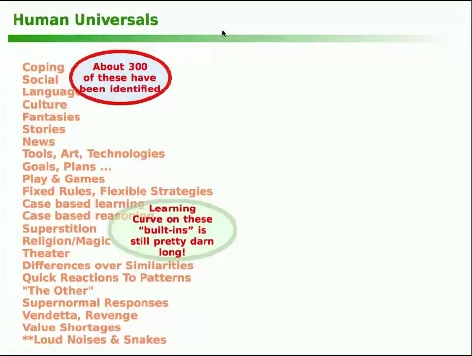
Anthropologists believe that if, at the birth of a child, he is transferred from one culture and brought up in another culture, he will be formed by the environment where he was raised. All entrepreneurs who are interested in profits: find out a list of these features and build technological amplifiers for it - success is guaranteed. And you can see that all profitable products today belong to this group. These items do not need to advertise, people are already predisposed to their use.
How our brain works

We perceive by sight through the eyes, and the information jumps in the brain from one place to another. Here are two concepts that show what our mind is. First: this and what we call “normal”, our context and beliefs, what we consider to be reality. We believe that our “norm” is the reality, and that is why it took us almost 200,000 years to invent science. We thought that we were already living in our reality, where everything is what we believe in, and why should we look for something deeper? I call this part of the brain a ghost, because in it, we believe that everything that is normal is reality. But also at times we have what I call “sleep”, because in fact consciousness is just a waking dream, but more limited to what is happening around us (as opposed to sleeping at night when we do not know what is happening around us).
That is, we live from moment to moment as if in our own hallucination

As proof, here is an example: if you have 2 coins and you know that they are the same size, keep one at such a distance so that it is two times farther away than the other. The one that is further should be half the size of the one that is closer, but it does not look that way. Where does this illusion come from? It is well known as “size constancy”.

Descartes showed that imaging on the retina is indeed half the size. At this moment, our “ghost” sees one thing, but “dream” says that this vision is not the truth, and we see some compromise between the “ghost” and “sleep”. Many of the judgments to which people resort are not true, because they analyze based on the perception of the situation “ghost”. From this we conclude that normal is almost asleep, because we have limited our analysis without noticing it.
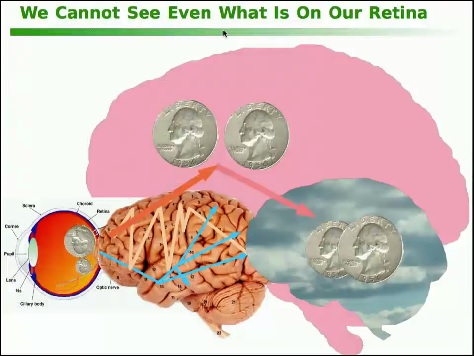
Further, anthropologists have seen, along with features that are universal for humanity, there are sufficient rarely encountered
For example, reading, writing, mathematics, equal rights - all these are inventions, we are not programmed by them from birth. They are difficult to study, and as far as can be seen, they began about 13,000 years ago, and were very irregular until recently. For example, the idea of how to survive or endure something is well known to us from birth, but the idea of progress arose only in the 18th century — when changes were so slow that everyone on the planet died in the same environment in which they were born — this invention.
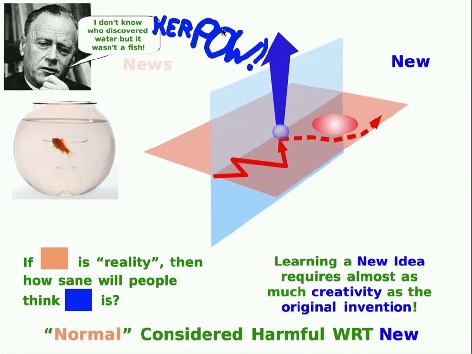
Suppose that you are 2 times smarter than Da Vinci, but were born 10,000 years BC. How far would you go? You would not have advanced at all, you would most likely be burned at the stake. But Henry Ford, who was not as clever as Da Vinci, was born at a time when knowledge was already known to people, much was already revealed, and he did not need to reinvent the gasoline engine.
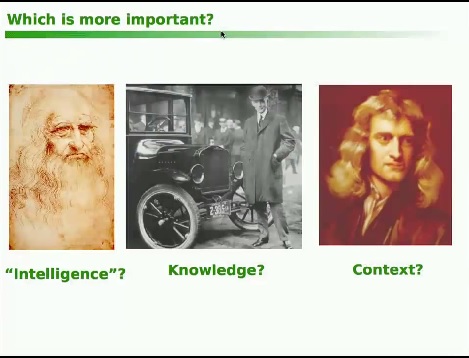
Everything was already invented, and Ford was just an innovator: he organized the production, and delivered the invention to the masses. Therefore, knowledge dominates the intellect, if you see that they go in isolation from each other. And the question is - why Ford could do what he did? The answer is that a genius named Newton changed the way people think. People began to think like they had never thought before, and if you think about the amount of value Newton created, it is simply unthinkable, because almost all technologies exist because of Newton. And therefore, inventions must be treated with great attention. Previously, this country financed inventions, but now, for some reason, about which I no longer have time to talk, inventions are no longer funded.
The present tense is simply overwhelming, because we have such a small brain, and we are mostly busy with real (current) events.

But the present has come out of a small part of the past, and we pay attention only to this part of the past, if we look back at all. There is a book of the 1840s, the author of which made the observation that "Americans have neither the past nor the future - they live in the continuation of the present." And this accurately characterizes us today. Thus, it is difficult for people living in the present to accept any sudden changes. But the least important time in which we live is the present. If we understand that the present is a structure created by our system and our beliefs, we can understand that we can create any other structure.

And that was the way the United States was built: Thomas Payne, in Common Sense, wrote “why should the king be the law when the law can be the king?” That is, he understood that it was possible to build another system and put it into law. Seeing the present in this light, we discover the past for ourselves, because we remove the special status of that small fraction of the past from which our present was created. And this allows us to dream about what might be in the future. Having opened the past, we can borrow the inventions of that time, process them, and get new ideas, unlike anything from the present. But this process is rarely used today.
You can see this as follows: we are taught in school to solve problems, but this is a wrong idea, because problems arise naturally from our present, from what we do. In fact, you need to learn how to find and set tasks. Just think - the current concept of a creative person is a person who can point out obvious problems. But this is only a display of the current worldview, and really may not be a real problem.
We can only make changes by discovering what is the real problem.
The man who owned it well is Wayne Gretzky, known as the best hockey player ever. In an interview, he was told that he makes many throws and misses, to which he replied: “A person misses 100% of those throws that he does not, so why not try?” He also said that “a good hockey player follows the puck, and a great hockey player follows where the puck is. ”The second part is new. And he did not mean assessing where the puck would go, but to take a place where he could make a pass so that he could score a goal. And so he has more goals than anyone.
In Xerox PARC, one of the games we played and was called - Wayne Gretzky game

The essence of the game: fix the puck far in the future, much further than 3 months, as the previous speaker said (I found it completely ridiculous). The idea of our game was to take the puck 30 years into the future, so far that there was no known visible path to it. Thus, in 1968 I decided that inevitably we would have laptops in the future, that was the technological reason, the reason for the consumer, and the reason for education. But playing this game, you need to get closer to the present, and think about what your idea will be in 10-15 years to get closer to what will be in 30 years.

Such a device has the hardware and software of the future, and you need to create it now, because it will take decades to fundamentally change the hardware and hardware for a new device. This can be done through money, doubling funding every 18 months - this is Moore's law, on the contrary. And so we came to the Alto computer, the predecessor of the Macintosh — it cost $ 85,000 in 1973, and this was the first simulation of a laptop. This machine was so powerful that you could do anything on it, especially experiments with the interface. Nowadays, this is one of the problems - we do not yet know how to develop good interfaces, because no one is experimenting with them. But in Xerox PARC we experimented with it just the same. And this car was so fast that we didn't need to optimize, and we had time for a beer after dinner.
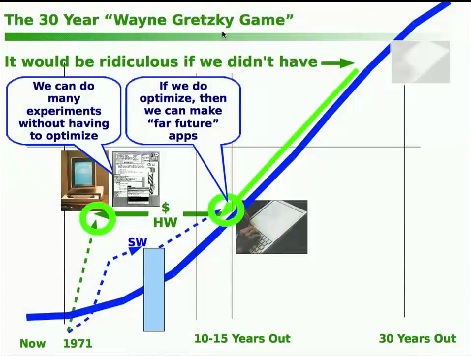
Returning to work, we continued to play with the interface. And we created, for example, Microsoft Word - it was made at Xerox PARC and was tested on Alto in 1974, and brought a lot of Microsoft money in the 80s.
If you think, in fact, all this is inexpensive, compared to what we learn from the whole process.
I go to the climax
Let's go into the past for 7 years, it will be 2007. What then was it? I remember this year well, at that time the financial community stole our money. In general, 7 years time difference, how does it feel? Not so long ago. But let's see what could have been created in those 7 years.
If at that time they had planning for 10 years (today it may be related to communications, or something related to “big sense”, instead of “big data”). If you play Wayne Gretzky’s game, your vision will be further than what you’ll actually work on. Of these 10 years, at least 5 years should be spent on research. This is psychologically important, because if you spend 3 years on research, scientists and engineers will be doing completely different things than those that really need to do. Those. if you do not give them 5 years, then your project will be limited to 10 years. The same with the horizon of innovation for these inventions.

You have a transition process from inventions to innovations, and if you take all this together, then the actual time spent on real inventions and their innovation is not that big. But people do not go through these steps, they have a small idea based on something from the category of “fires and tales”, for convenience and simplicity (from the list on the left side of the screen shown earlier), and immediately begin to enter the market. And for them it is good if people like it, but for the future it is bad, because it leads to paralysis of thinking about what we do. For example, only scientists and engineers use computers for what they are really good for, everyone else uses them as convenient means for doing all the same things as before, and not new methods of use, as Stephen Wolfram said.
It was a brief overview of the inventive process, why people have problems with perceiving the new, and a look at how to proceed further. Thank.
Who wants to help with the translation of useful thoughts of Alan Kay, write magisterludi2016@yandex.ru
More publications by Alan Kay in Russian:
- Happy birthday, Alan Keyǃ (or how to get +80 to IQ)
- Alan Kay: The future of "reading" depends on the future of "learning difficult to understand things"
- Biography of Alan Kay and key achievements
- Why Alan Kay dislikes Wikipedia, PowerPoint, OOP, and programming patterns
- Thousands of compact code
- Thousand-fold compact code] [
- How to raise people from our kids with the help of IT
- Why do kids think in differential geometry categories?
- Alan Kay about the future of programming
- System STEPS: twenty thousand lines of code that will change the programming, operating systems and the Internet
- Counterargument on Habré
Source: https://habr.com/ru/post/350830/
All Articles